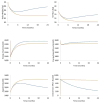Maintenance of Lost Weight and Long-Term Management of Obesity
- PMID: 29156185
- PMCID: PMC5764193
- DOI: 10.1016/j.mcna.2017.08.012
Maintenance of Lost Weight and Long-Term Management of Obesity
Abstract
Weight loss can be achieved through a variety of modalities, but long-term maintenance of lost weight is much more challenging. Obesity interventions typically result in early weight loss followed by a weight plateau and progressive regain. This review describes current understanding of the biological, behavioral, and environmental factors driving this near-ubiquitous body weight trajectory and the implications for long-term weight management. Treatment of obesity requires ongoing clinical attention and weight maintenance-specific counseling to support sustainable healthful behaviors and positive weight regulation.
Keywords: Appetite; Behavioral counseling; Obesity treatment; Physiology; Weight loss; Weight maintenance.
Published by Elsevier Inc.
Conflict of interest statement
Figures



Similar articles
-
Physiological adaptations to weight loss and factors favouring weight regain.Int J Obes (Lond). 2015 Aug;39(8):1188-96. doi: 10.1038/ijo.2015.59. Epub 2015 Apr 21. Int J Obes (Lond). 2015. PMID: 25896063 Free PMC article. Review.
-
Associations of internet website use with weight change in a long-term weight loss maintenance program.J Med Internet Res. 2010 Jul 27;12(3):e29. doi: 10.2196/jmir.1504. J Med Internet Res. 2010. PMID: 20663751 Free PMC article.
-
Intermittent fasting interventions for the treatment of overweight and obesity in adults aged 18 years and over: a systematic review protocol.JBI Database System Rev Implement Rep. 2015 Oct;13(10):60-8. doi: 10.11124/jbisrir-2015-2363. JBI Database System Rev Implement Rep. 2015. PMID: 26571283
-
The defence of body weight: a physiological basis for weight regain after weight loss.Clin Sci (Lond). 2013 Feb;124(4):231-41. doi: 10.1042/CS20120223. Clin Sci (Lond). 2013. PMID: 23126426 Review.
-
Biological mechanisms that promote weight regain following weight loss in obese humans.Physiol Behav. 2013 Aug 15;120:106-13. doi: 10.1016/j.physbeh.2013.07.009. Epub 2013 Aug 1. Physiol Behav. 2013. PMID: 23911805 Free PMC article. Review.
Cited by
-
Primary care-led weight-management intervention: qualitative insights into patient experiences at two-year follow-up.Int J Qual Stud Health Well-being. 2023 Dec;18(1):2276576. doi: 10.1080/17482631.2023.2276576. Epub 2023 Nov 20. Int J Qual Stud Health Well-being. 2023. PMID: 38016037 Free PMC article.
-
Community-based care needs for adults with class III obesity before and after tertiary weight management: An exploratory study.Obes Sci Pract. 2024 Jan 11;10(1):e732. doi: 10.1002/osp4.732. eCollection 2024 Feb. Obes Sci Pract. 2024. PMID: 38213316 Free PMC article.
-
The Unrestrained Overeating Behavior and Clinical Perspective.Adv Exp Med Biol. 2024;1460:167-198. doi: 10.1007/978-3-031-63657-8_6. Adv Exp Med Biol. 2024. PMID: 39287852 Review.
-
Trending Weight Loss Between Usual Care and Bariatric Surgery Among Higher Weight Persons With Obstructive Sleep Apnea.Cureus. 2022 Nov 30;14(11):e32052. doi: 10.7759/cureus.32052. eCollection 2022 Nov. Cureus. 2022. PMID: 36600828 Free PMC article.
-
Weight Loss Trajectories and Related Factors in a 16-Week Mobile Obesity Intervention Program: Retrospective Observational Study.J Med Internet Res. 2022 Apr 15;24(4):e29380. doi: 10.2196/29380. J Med Internet Res. 2022. PMID: 35436211 Free PMC article.
References
-
- Wing RR, Phelan S. Long-term weight loss maintenance. Am J Clin Nutr. 2005;82(1 Suppl):222S–225S. - PubMed
-
- Wu T, Gao X, Chen M, van Dam RM. Long-term effectiveness of diet-plus-exercise interventions vs. diet-only interventions for weight loss: a meta-analysis. Obes Rev. 2009;10(3):313–323. - PubMed
-
- Anderson JW, Konz EC, Frederich RC, Wood CL. Long-term weight-loss maintenance: a meta-analysis of US studies. Am J Clin Nutr. 2001;74(5):579–584. - PubMed
-
- Snook KR, Hansen AR, Duke CH, Finch KC, Hackney AA, Zhang J. Change in Percentages of Adults With Overweight or Obesity Trying to Lose Weight, 1988–2014. JAMA. 2017;317(9):971–973. - PubMed
Publication types
MeSH terms
Grants and funding
LinkOut - more resources
Full Text Sources
Other Literature Sources
Medical

